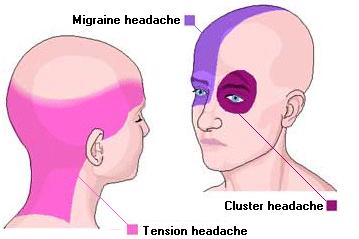The location of your headache can tell a clinician a great deal about what may be the cause. The most common form of headaches are sinus, tension, migraine and cluster headaches.
If your headache is caused by your sinuses then it is usually around the front of the head and face. It is characterised by dull, pressure like pain that worsens with sudden movements of the head and bending forward. Sinus headache may begin in the morning and gradually decrease in intensity as the day moves forward. It is caused by inflammation of the sinuses that may result from allergies like hay fever or infection such as flu. It can sometimes be associated with fatigue, fever, nasal congestion, nasal discharge, watery eyes etc.

If you are suffering from a tension headache you will usually have symptoms on both sides of the head. It is characterised by mild to moderate pain, which may be constant. It usually causes a feeling of tightness, constriction or pressure especially around the temples or the back of the head. The headache may be episodic or chronic, meaning it may last for long periods of time or the headache may come and go. Causes include muscular tension, lack of sleep, stress, overworking, fatigue, emotional crisis, menstruation etc.
If your headache is caused by a migraine then it is usually one side of the head. It is characterised by intense, throbbing and pulsating pain that is intermittent in nature. Each attack of headache may last for several hours or even days. Migraines are slightly more common in females between their 20s and 30s. In some cases, migraine is preceded by an ‘aura-phase’ in which visual, sensory, speech or motor disturbance may occur lasting around 10 to 15 minutes. For example, flickering, blurred or partial loss of vision, tingling or numbness in on one side of the hand etc. You may also experience sensitivity to light, smells, noise. Nausea and vomiting is also common and this type of headache may be triggered by stress and sometimes due to certain kind of foods.

A cluster headache is closely associated with migraine, in terms of similarity in pain features. It is characterised by severe, repeated episodes of pain, of about 30 minutes to 3 hours in duration. There can be 1 to 8 attacks per day, usually at night.
Cluster headaches sometimes disturb sleep. Its distribution is on one side of the head and usually around the eye. Pain maybe associated with drooping of the eyelid, weeping of the eye on the affected side and possible nasal congestion. Spontaneous remission can occur after several months of attacks.
A cervicogenic headache arises from the base of the skull and the upper part of the cervical spine or neck. It is typically a long lasting headache. This type of headache has a broader distribution as the headache may be felt in one or more regions of the head and/or face. These occur due to a neck disorder such as an irritation of the joints in the neck or muscular tightness leading to inflammation or irritation of structures around the neck.
Many types of headaches can be helped with manual therapy including osteopathy, physiotherapy, acupuncture or massage therapy. If you suffer with ongoing headaches we may be able to help. You can arrange an appointment with one of our practitioners at Cedar Hall Clinics in Benfleet or Thurrock to help diagnose and treat your head pain.

